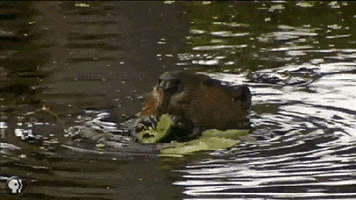Sediments trapped by beaver dams help remove excess nutrients in state waterways, Iowa State University researchers have learned through a first-of-its-kind project for Iowa.
The team found sediments trapped by beaver dams can reduce nitrates by 1 to 4 parts per million on average — which can add up to hundreds and even thousands of pounds per year across multiple dams, according to lead researcher Andrew Rupiper, an ISU master’s degree student.
“Regardless of where you're at in Iowa, we see significant sediment trapping and significant nitrate reduction when you compare to a non-dammed stream nearby,” said Rupiper, who presented the team’s ongoing findings Thursday at the 2022 Iowa Water Conference.
Advertisement
Beavers are native to Iowa and inhabit streams, rivers and other water bodies statewide. Their populations in Iowa rebounded after facing extinction in the 1900s and are estimated to have since grown into the tens of thousands.
Beaver research in the United States is almost exclusively focused in the West, Rupiper said. These ecosystems — and their beavers — behave differently than those in the Midwest. He said his team hopes to fill that gap with its ongoing research.
“There's been zero work done in that regard in the state of Iowa,” he said. “We're looking at the same critter doing some very different things.”
The team recorded the depths of sediment trapped by each beaver dam and calculated the total volume, which could amount to as much as 250,000 to 300,000 kilograms — or more than a half-million pounds.
Then, the researchers collected sediment samples to bring back to the lab.
There, they investigated if the samples had the right “ingredients” for nutrient reduction: low oxygen, slow water speeds and particle sizes ideal for microbes that consume the nutrients. They found that beaver dams can create ideal conditions for nutrient removal — mirroring human-made reduction efforts — for free.
Get weekly environment & outdoor news updates.
“We're letting them do what we've been trying to do for the last 50 years: build places for water to sit, trap and process like it needs to,” he said. “We can benefit from that.”
The research is part of a larger and continuing partnership between Iowa State University and the Iowa Nutrient Research Center to study the impacts of beaver dams on water quality, sedimentation and hydrology for Iowa waterways.
The presented findings only included results from two of the studied dams, although the team has surveyed around 20 dams. They plan to survey 30 to 40 dams within the next year to investigate any variability between waterways across Iowa, Rupiper said.

 www.thegazette.com
www.thegazette.com
The team found sediments trapped by beaver dams can reduce nitrates by 1 to 4 parts per million on average — which can add up to hundreds and even thousands of pounds per year across multiple dams, according to lead researcher Andrew Rupiper, an ISU master’s degree student.
“Regardless of where you're at in Iowa, we see significant sediment trapping and significant nitrate reduction when you compare to a non-dammed stream nearby,” said Rupiper, who presented the team’s ongoing findings Thursday at the 2022 Iowa Water Conference.
Advertisement
Beavers are native to Iowa and inhabit streams, rivers and other water bodies statewide. Their populations in Iowa rebounded after facing extinction in the 1900s and are estimated to have since grown into the tens of thousands.
Beaver research in the United States is almost exclusively focused in the West, Rupiper said. These ecosystems — and their beavers — behave differently than those in the Midwest. He said his team hopes to fill that gap with its ongoing research.
“There's been zero work done in that regard in the state of Iowa,” he said. “We're looking at the same critter doing some very different things.”
The team recorded the depths of sediment trapped by each beaver dam and calculated the total volume, which could amount to as much as 250,000 to 300,000 kilograms — or more than a half-million pounds.
Then, the researchers collected sediment samples to bring back to the lab.
There, they investigated if the samples had the right “ingredients” for nutrient reduction: low oxygen, slow water speeds and particle sizes ideal for microbes that consume the nutrients. They found that beaver dams can create ideal conditions for nutrient removal — mirroring human-made reduction efforts — for free.
Newsletter signup
Get weekly environment & outdoor news updates.
“We're letting them do what we've been trying to do for the last 50 years: build places for water to sit, trap and process like it needs to,” he said. “We can benefit from that.”
The research is part of a larger and continuing partnership between Iowa State University and the Iowa Nutrient Research Center to study the impacts of beaver dams on water quality, sedimentation and hydrology for Iowa waterways.
The presented findings only included results from two of the studied dams, although the team has surveyed around 20 dams. They plan to survey 30 to 40 dams within the next year to investigate any variability between waterways across Iowa, Rupiper said.
Beaver dams do a dam good job improving Iowa water quality
Researchers find the barriers can remove nutrients from waterways




